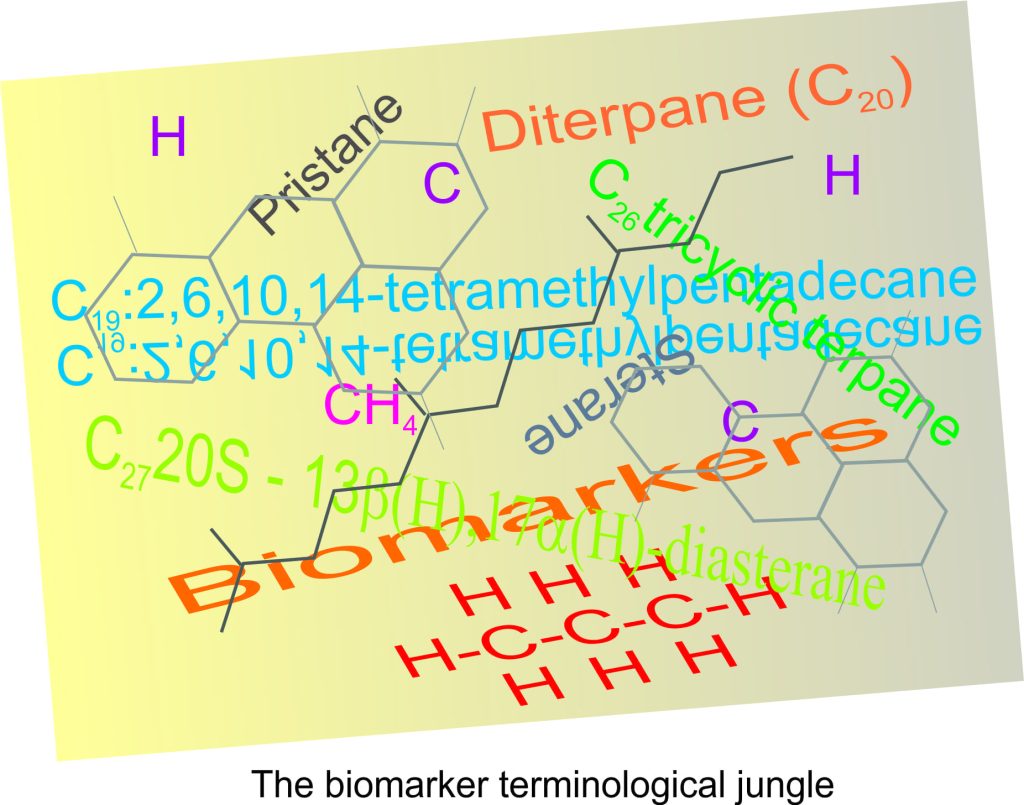I like a good detective thriller. Danish, Norwegian, Swedish and Britain’s BBC networks have produced some quality shows over the past few years. Forensics is usually equated with ‘who dunnit?’ but science also makes use of forensic-like tools to help unravel mysteries and solve problems. This post looks at certain chemical compounds found in hydrocarbon deposits. The compounds are specific, complex organic molecules called biomarkers. Biomarkers provide scientific fingerprints of oil deposits, that help scientists and oil explorationists decipher the where, when and how such deposits formed, and environmental scientists monitoring the migration and degradation of spilled oil.
What is a biomarker?
Hydrocarbons are derived from organic matter, the stuff of all living things. Organic matter, and the molecules that it is composed of undergo chemical transformations as they are buried and heated beneath 100s to 1000s of metres of sediment, a process known as maturation.
The oil-forming processes take millions of years, during which most of the original organic compounds, or molecules, transform to new compounds. Crude oils are known to contain many 1000s of these compounds. The chemical composition of crude oils varies depending on the composition of the original organic matter; crude oils derived from marine plankton commonly have different molecular compounds to those derived from vegetation.
Fortuitously, some organic molecules survive the burial, heating, and chemical transformations. We can think of these as molecular fossils. Their identification in crude oils tells us something about the original organic matter, and therefore the kind of plant or animal from which it came. The equipment required to perform these analyses is pretty sophisticated, requiring very clean labs and robust sampling methods. But if you have access to an Ultrahigh-resolution Fourier Transform Ion Cyclotron Resonance Mass Spectrometer, then the dividends are probably worth the effort and expense.
Most biomarker molecules have complex structures involving many carbon, oxygen, nitrogen and sulphur atoms – a hint at this complexity is shown in the cartoon above. Their chemical names can also be a bit of a mouthful (24-n-propylcholestane, or Tetracyclic diterpene). Organic chemists thrive on this complexity. However, this complexity allows analysts to identify organic matter from different sources:
- Marine deposits (plankton, algae)
- Freshwater lakes (plankton such as diatoms, algae)
- Flowering plants, conifers etc. in coal
- Hypersaline deposits (very salty) lagoons, salt marshes
- Carbonate rock (limestone, dolomite), such as ancient reefs
- Oxygen-deficient environments (anoxic) such as water bodies with low turn-over
Tracking biomarkers
Biomarker fingerprints help an investigator decipher where an oil deposit came from, what its biological source was, in some cases how old an oil deposit is, how environmental degradation of oil proceeds, and identify the culprits who spill this stuff, especially into waterways.
Live oils generally reside in porous and permeable rocks (e.g. sandstones, limestones), or reservoirs; reservoirs are analogous to aquifers in which groundwater flows. However, oils do not form in reservoirs; they form from organic-rich sediments that are buried, on average, 3-4km beneath the surface. Once formed, the oil migrates (seeps, slowly) through porous rock until it is trapped – this is the reservoir. Analysis of molecular biomarkers in the oil (assuming the oil has been discovered) will indicate the kind of organic material from which the oil was sourced (as in the list above). The next task is to look for possible source-rock candidates in the geological column of sedimentary rock. If a likely source is identified, it is then possible to map migration routes that the oil might have taken to get to the discovered reservoir. For the explorationist, knowing the migration road map enhances the possibility of finding an, as yet, undiscovered reservoir. Biomarkers are also useful from an environmental forensic perspective. Oil spills in waterways are commonly difficult to pin point in terms of ‘who dunnit’. Chemical analysis of a spill, especially the biomarkers, can help identify likely candidates who deserve further investigation, and who might be persuaded to assist in the recovery of remediation costs.
Biomarkers are also useful from an environmental forensic perspective. Oil spills in waterways are commonly difficult to pin point in terms of ‘who dunnit’. Chemical analysis of a spill, especially the biomarkers, can help identify likely candidates who deserve further investigation, and who might be persuaded to assist in the recovery of remediation costs.
Precambrian oil; fingerprinting really ancient life forms
At a cellular level, the two most basic life forms are the Prokaryotes (cells lacking a nucleus bound by membranes) and Eukaryotic cells that possess a nucleus containing the genetic material and all the bits and pieces that drive respiration and other cell functions. The Prokaryotes include bacteria and cyanobacteria (sometimes called blue-green algae) that, in the Precambrian era, constructed extensive algal mats and stromatolites. Eukaryotes include all other more complex, multi-cellular life forms, such as red algae and homo sapiens. Certain groups of molecular biomarkers are unique to one or other cell types; hopanes in Prokaryotes, and steranes in Eukaryotes. Both types are complex molecules consisting of many 6-sided carbon rings. The biomarkers are important because they provide a glimpse, at the molecular level, of the earliest, complex, multicellular life forms.
The oldest identifiable cyanobacteria, in the form of algal mats and fossil cells from Australia, are about 3.4 billion years old. Analysis of ancient rocks that contain remnants of oil and organic matter indicate that hopanes predominated at least to about 1 billion years ago, but that hints of sterane compounds are seen as far back as 2.7 billion years. This tells us that cellular evolution had advanced to the stage where complex multicellular organisms, perhaps like red algae, had developed very early in earth history even though they were a relatively minor part of the biomass at that time. The oldest actual Eukaryotic cell fossils are about 1800-1600 million years old from China. The oldest known live oil, from McArthur Basin in northern Australia, is about 1.3 billion (1300 million) years old. Biomarkers from the McArthur oil indicate mostly Prokaryotic organisms and traces of Eukaryotes.
So it seems that, although Eukaryotes evolved very early in the history of life, they did not become prominent until much later in the Precambrian, perhaps about 1000-800 million years ago. The oldest metazoans (recognizable animals) are 575 million years old; this is the Ediacaran fauna – a topic for a future post.
If you are into chemistry, here is a technical paper on biomarkers; download the PDF
There is a good technical paper on Precambrian hydrocarbon chemistry available for download here.
Terra satellite image credit: Jesse Allen/NASA/GSFC/METI/ERSDAC/JAROS, and U.S./Japan ASTER Science Team


















